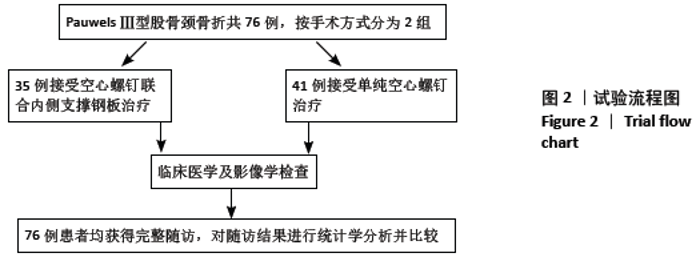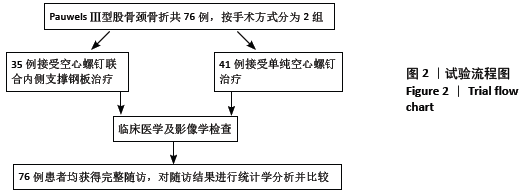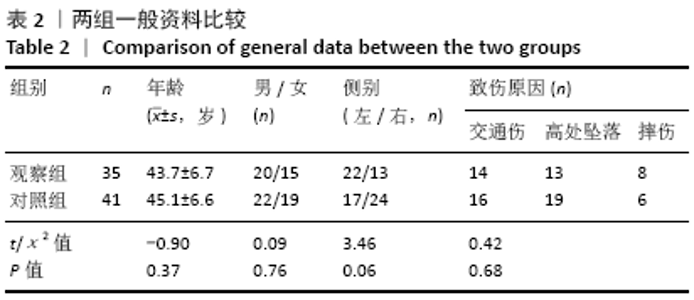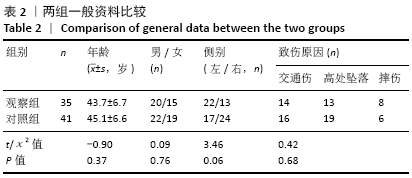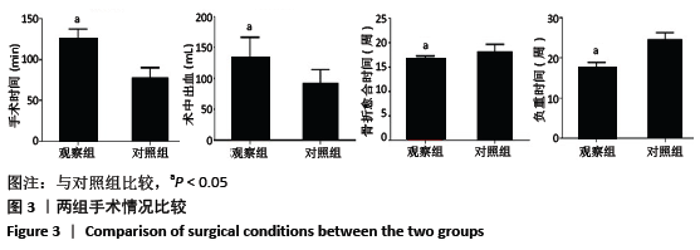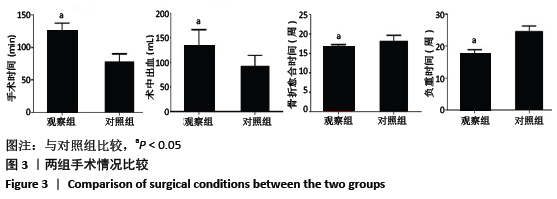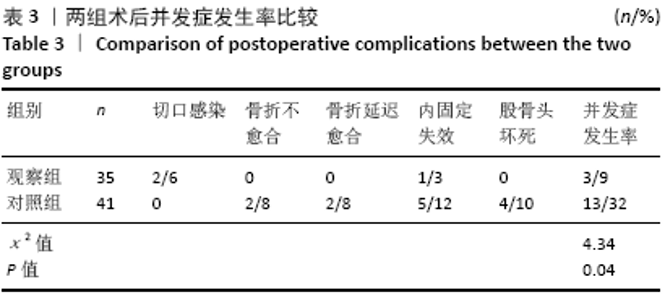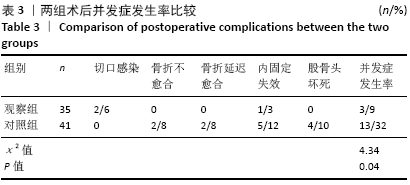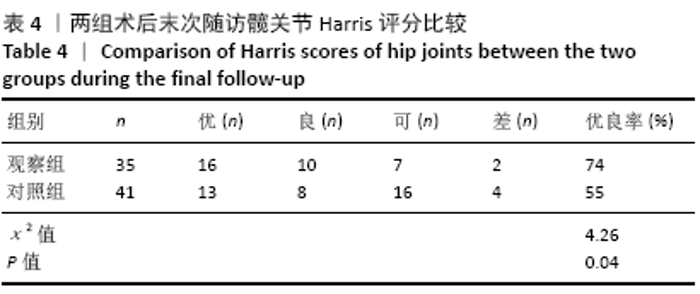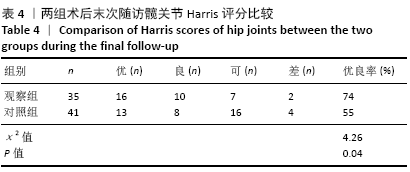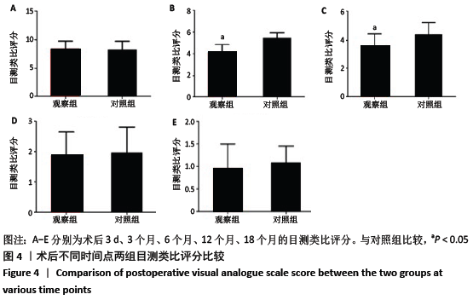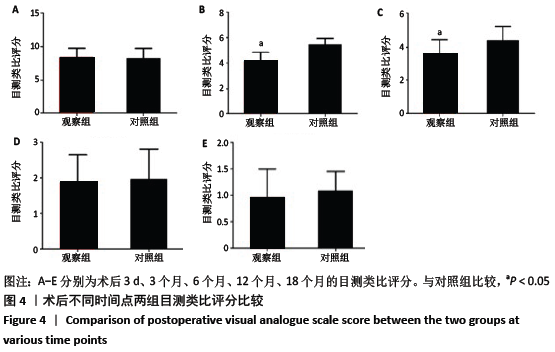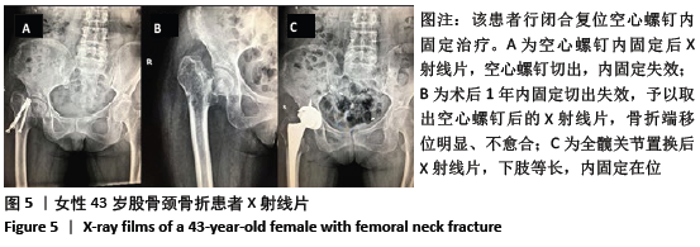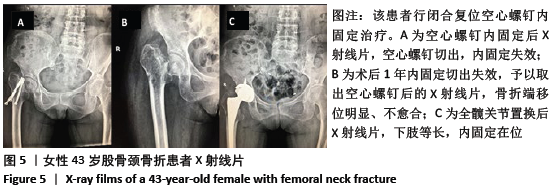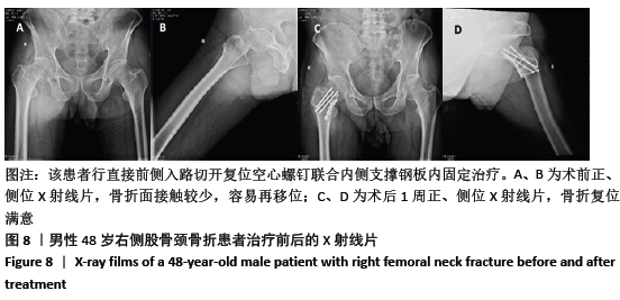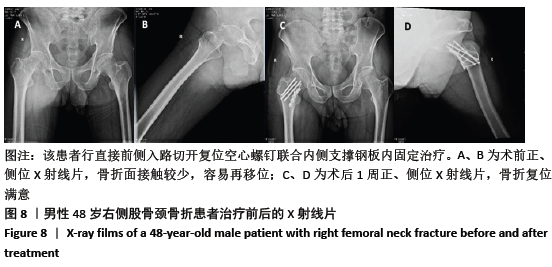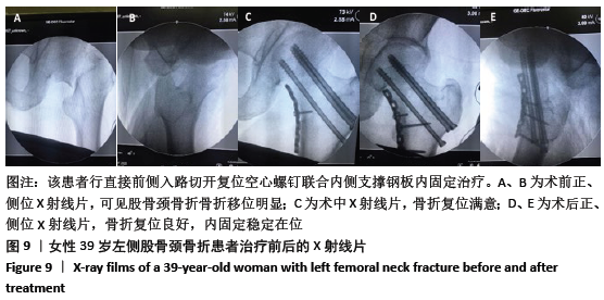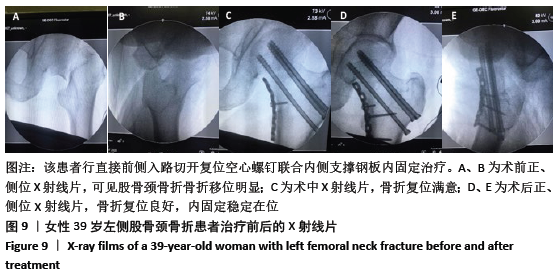Chinese Journal of Tissue Engineering Research ›› 2021, Vol. 25 ›› Issue (18): 2869-2874.doi: 10.3969/j.issn.2095-4344.3830
Previous Articles Next Articles
Cannulated screw combined with buttress plate in treatment of Pauwels III femoral neck fracture in middle-aged and young adults
Wei Feng, Zhou Yejin, Yao Tao, Shan Tao
- Department of Orthopedic Trauma, The Third Affiliated Hospital of Anhui Medical University, Hefei 230001, Anhui Province, China
-
Received:2020-06-20Revised:2020-06-30Accepted:2020-07-29Online:2021-06-28Published:2021-01-18 -
Contact:Zhou Yejin, Chief physician, Department of Orthopedic Trauma, The Third Affiliated Hospital of Anhui Medical University, Hefei 230001, Anhui Province, China -
About author:Wei Feng, Master candidate, Physician, Department of Orthopedic Trauma, The Third Affiliated Hospital of Anhui Medical University, Hefei 230001, Anhui Province, China
CLC Number:
Cite this article
Wei Feng, Zhou Yejin, Yao Tao, Shan Tao. Cannulated screw combined with buttress plate in treatment of Pauwels III femoral neck fracture in middle-aged and young adults[J]. Chinese Journal of Tissue Engineering Research, 2021, 25(18): 2869-2874.
share this article
| [1] CAMPBELL BJ. Osteoporosis: the basics and case-based advanced treatment update for the orthopaedic surgeon. Instr Course Lect. 2008;57:595-636. [2] PAUYO T, DRAGER J, ALBERS A, et al. Management of femoral neck fractures in the young patient: A critical analysis review. World J Orthop. 2014;5(3):204-217. [3] TIANYE L, PENG Y, JINGLI X, et al. Finite element analysis of different internal fixation methods for the treatment of Pauwels type III femoral neck fracture. Biomed Pharmacother. 2019;112:108658. [4] SAMSAMI S, SABERI S, SADIGHI S. Comparison of Three Fixation Methods for Femoral Neck Fracture in Young Adults: Experimental and Numerical Investigations. J Med Biol Eng. 2015;35:566-579. [5] 姜达君,贾伟涛,张长青.青壮年股骨颈骨折复位技巧和内固定选择[J].中华创伤骨科杂志,2018,20(7):588-593. [6] HARRIS WH. Traumatic arthritis of the hip after dislocation and acetabular fractures: treatment by mold arthroplasty. An end-result study using a new method of result evaluation. J Bone Joint Surg Am. 1969;51(4):737-755. [7] PROTZMAN RR. Femoral-neck fractures in young adults. J Bone Joint Surg Am. 1976;58:689-695. [8] DEDRICK DK, MACKENZIE JR. Complications of femoral neck fracture in young adults. J Trauma. 1986;26:932-937. [9] Holmberg S, Kalén R. Treatment and outcome of femoral neck fractures. An analysis of 2418 patients admitted from their own homes. Clin Orthop Relat Res. 1987;(218):42-52. [10] 李智勇,张奇,陈伟,等.难复位性股骨颈骨折的概念提出与治疗[J].中华创伤骨科杂志,2011,13(11):1020-1023. [11] COLLINGE CA, MIR H. Fracture morphology of high shear angle “vertical” femoral neck fractures in young adult patients. J Orthop Trauma. 2014;28:270-275. [12] HAIDUKEWYCH GJ, ROTHWELL WS, JACOFSKY DJ, et al. Operative treatment of femoral neck fractures in patients between the ages of fifteen and fifty years. J Bone Joint Surg Am. 2004;86-A:1711-1716. [13] LIPORACE F, GAINES R, COLLINGE C. Results of internal fixation of Pauwels type-3 vertical femoral neck fractures. J Bone Joint Surg Am. 2008;90:1654-1659. [14] 赵奇,刘世清,明江华,等.加压空心螺纹钉置入治疗成人股骨颈骨折:内固定失效分析[J].中国组织工程究,2014,18(44):7138-7145. [15] WIRTZ C, ABBASSI F, EVANGELOPOULOS DS, et al. High failure rate of trochanteric fracture osteosynthesis with proximal femoral locking compression plate. Injury. 2013;44:751-756. [16] BERKES MB, LITTLE MT, LAZARO LE, et al. Catastrophic failure after open reduction internal fixation of femoral neck fractures with a novel locking plate implant. J Orthop Trauma. 2012;26(10):e170-e176. [17] LEVACK AE, GAUSDEN EB, DVORZHINSKIY A, et al. Novel Treatment Options for the Surgical Management of Young Femoral Neck Fractures. J Orthop Trauma. 2019;33 Suppl 1:S33-S37. [18] LAZARO LE, BIRNBAUM JF, FARSHAD-AMACKER NA, et al. Endosteal Biologic Augmentation for Surgical Fixation of Displaced Femoral Neck Fractures. J Orthop Trauma. 2016;30:81-88. [19] TIDERMARK J, PONZER S, SVENSSON O, et al. Internal fixation compared with total hip replacement for displaced femoral neck fractures in the elderly. A randomised, controlled trial. J Bone Joint Surg Br. 2003;85:380-388. [20] NAIR N, PATRO DK. Role of muscle pedicle bone graft as an adjunct to open reduction and internal fixation in the management of neglected and ununited femoral neck fracture in young adults: a prospective study of 17 cases. Eur J Orthop Surg Traumatol. 2014;24:1185-1191. [21] CHA YH, YOO JI, HWANG SY, et al. Biomechanical Evaluation of Internal Fixation of Pauwels Type III Femoral Neck Fractures: A Systematic Review of Various Fixation Methods. Clin Orthop Surg. 2019;11:1-14. [22] BLAIR JA, STINNER DJ, KIRBY JM, et al. Quantification of femoral neck exposure through a minimally invasive Smith-Petersen approach. J Orthop Trauma. 2010; 24:355-358. [23] MIR H. Application of a medial buttress plate may prevent many treatment failures seen after fixation of vertical femoral neck fractures in young adults. Med Hypotheses. 2015; 84: 429-433. [24] STACEY SC, RENNINGER CH, HAK D. Tips and tricks for ORIF of displaced femoral neck fractures in the young adult patient. Eur J Orthop Surg Traumatol. 2016;26:355-363. [25] MANNINGER J, KAZAR G, FEKETE G, et al. Significance of urgent (within 6h) internal fixation in the management of fractures of the neck of the femur. Injury. 1989;20:101-105. [26] SWIONTKOWSKI MF, WINQUIST RA. Fractures of the femoral neck in patients between the ages of twelve and forty-nine years. J Bone Joint Surg Am. 1984;66:837-846. [27] PUTNAM SM, COLLINGE CA, GARDNER MJ, et al. Vascular Anatomy of the Medial Femoral Neck and Implications for Surface Plate Fixation. J Orthop Trauma. 2019; 33:111-115. [28] KUMAR MN, BELEHALLI P. PET/CT study of temporal variations in blood flow to the femoral head following low-energy fracture of the femoral neck. Orthopedics. 2014;37:e563-570. [29] WANG Z, GU L. Open Reduction and Internal Fixation and Intraoperative Exploration of the Superior Retinacular Arterial System in Young Adults Garden III Femoral Neck Fracture: A 10 Case Report. Ann Plast Surg. 2020;84:S222-S224. [30] 赵海燕,夏亚一,康鹏德.直接前入路全髋关节置换与加速康复外科[J].中国矫形外科杂志,2017,25(15):1390-1393. [31] MANNIGER J, BOSCH U, CSERHATI P, et al. Internal fixation of femoral neck fractures. Springer, NewYork, 2007. [32] KUNAPULI SC, SCHRAMSKI MJ, LEE AS, et al. Biomechanical analysis of augmented plate fixation for the treatment of vertical shear femoral neck fractures. J OrthopTrauma. 2015;29:144-150. [33] 陈海宏,张庆文,高大伟,等.螺钉内固定治疗PauwelsⅢ型股骨颈骨折发生股骨头缺血性坏死的影响因素[J].中国组织工程研究,2019,23(36):5782-5787. [34] PEI F, ZHAO R, LI F, et al. Osteonecrosis of femoral head in young patients with femoral neck fracture: a retrospective study of 250 patients followed for average of 7.5 years. J Orthop Surg Res. 2020;15(1):238. |
| [1] | Hu Kai, Qiao Xiaohong, Zhang Yonghong, Wang Dong, Qin Sihe. Treatment of displaced intra-articular calcaneal fractures with cannulated screws and plates: a meta-analysis of 15 randomized controlled trials [J]. Chinese Journal of Tissue Engineering Research, 2021, 25(9): 1465-1470. |
| [2] | Huang Dengcheng, Wang Zhike, Cao Xuewei. Comparison of the short-term efficacy of extracorporeal shock wave therapy for middle-aged and elderly knee osteoarthritis: a meta-analysis [J]. Chinese Journal of Tissue Engineering Research, 2021, 25(9): 1471-1476. |
| [3] | Xu Feng, Kang Hui, Wei Tanjun, Xi Jintao. Biomechanical analysis of different fixation methods of pedicle screws for thoracolumbar fracture [J]. Chinese Journal of Tissue Engineering Research, 2021, 25(9): 1313-1317. |
| [4] | Jiang Yong, Luo Yi, Ding Yongli, Zhou Yong, Min Li, Tang Fan, Zhang Wenli, Duan Hong, Tu Chongqi. Von Mises stress on the influence of pelvic stability by precise sacral resection and clinical validation [J]. Chinese Journal of Tissue Engineering Research, 2021, 25(9): 1318-1323. |
| [5] | Zhang Tongtong, Wang Zhonghua, Wen Jie, Song Yuxin, Liu Lin. Application of three-dimensional printing model in surgical resection and reconstruction of cervical tumor [J]. Chinese Journal of Tissue Engineering Research, 2021, 25(9): 1335-1339. |
| [6] | Zhang Yu, Tian Shaoqi, Zeng Guobo, Hu Chuan. Risk factors for myocardial infarction following primary total joint arthroplasty [J]. Chinese Journal of Tissue Engineering Research, 2021, 25(9): 1340-1345. |
| [7] | Wei Wei, Li Jian, Huang Linhai, Lan Mindong, Lu Xianwei, Huang Shaodong. Factors affecting fall fear in the first movement of elderly patients after total knee or hip arthroplasty [J]. Chinese Journal of Tissue Engineering Research, 2021, 25(9): 1351-1355. |
| [8] | Wang Jinjun, Deng Zengfa, Liu Kang, He Zhiyong, Yu Xinping, Liang Jianji, Li Chen, Guo Zhouyang. Hemostatic effect and safety of intravenous drip of tranexamic acid combined with topical application of cocktail containing tranexamic acid in total knee arthroplasty [J]. Chinese Journal of Tissue Engineering Research, 2021, 25(9): 1356-1361. |
| [9] | Xiao Guoqing, Liu Xuanze, Yan Yuhao, Zhong Xihong. Influencing factors of knee flexion limitation after total knee arthroplasty with posterior stabilized prostheses [J]. Chinese Journal of Tissue Engineering Research, 2021, 25(9): 1362-1367. |
| [10] | Huang Zexiao, Yang Mei, Lin Shiwei, He Heyu. Correlation between the level of serum n-3 polyunsaturated fatty acids and quadriceps weakness in the early stage after total knee arthroplasty [J]. Chinese Journal of Tissue Engineering Research, 2021, 25(9): 1375-1380. |
| [11] | Zhang Chong, Liu Zhiang, Yao Shuaihui, Gao Junsheng, Jiang Yan, Zhang Lu. Safety and effectiveness of topical application of tranexamic acid to reduce drainage of elderly femoral neck fractures after total hip arthroplasty [J]. Chinese Journal of Tissue Engineering Research, 2021, 25(9): 1381-1386. |
| [12] | Wang Haiying, Lü Bing, Li Hui, Wang Shunyi. Posterior lumbar interbody fusion for degenerative lumbar spondylolisthesis: prediction of functional prognosis of patients based on spinopelvic parameters [J]. Chinese Journal of Tissue Engineering Research, 2021, 25(9): 1393-1397. |
| [13] | Lü Zhen, Bai Jinzhu. A prospective study on the application of staged lumbar motion chain rehabilitation based on McKenzie’s technique after lumbar percutaneous transforaminal endoscopic discectomy [J]. Chinese Journal of Tissue Engineering Research, 2021, 25(9): 1398-1403. |
| [14] | Chen Xinmin, Li Wenbiao, Xiong Kaikai, Xiong Xiaoyan, Zheng Liqin, Li Musheng, Zheng Yongze, Lin Ziling. Type A3.3 femoral intertrochanteric fracture with augmented proximal femoral nail anti-rotation in the elderly: finite element analysis of the optimal amount of bone cement [J]. Chinese Journal of Tissue Engineering Research, 2021, 25(9): 1404-1409. |
| [15] | Du Xiupeng, Yang Zhaohui. Effect of degree of initial deformity of impacted femoral neck fractures under 65 years of age on femoral neck shortening [J]. Chinese Journal of Tissue Engineering Research, 2021, 25(9): 1410-1416. |
| Viewed | ||||||
|
Full text |
|
|||||
|
Abstract |
|
|||||
